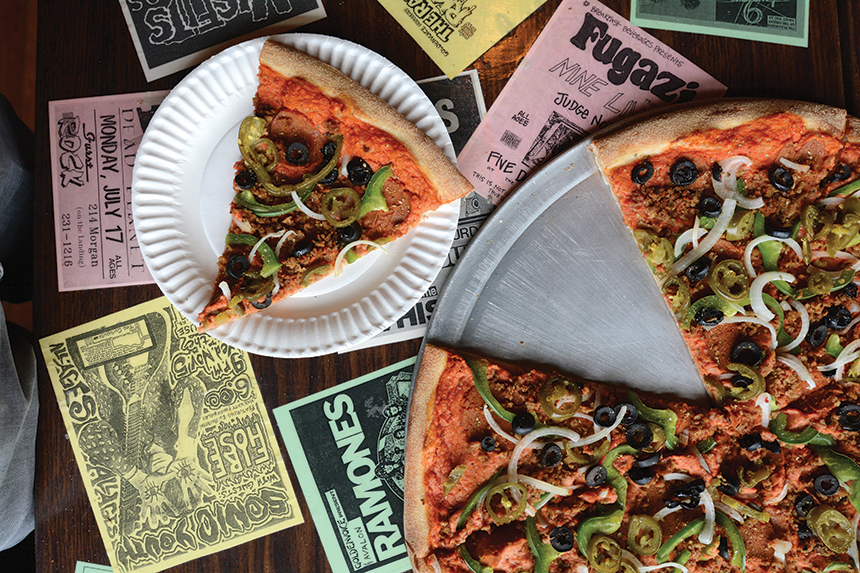Pizzeria operators can incorporate these innovative ingredients to answer consumer demand
Plant-based ingredients are gaining popularity, including on pizza. According to Datassential, plant-based items have been rapidly growing in menu prevalence, and are expected to be on 40 percent of menus by 2025. These menu items include not just veggie burgers and tofu scramble, but pizza toppings such as non-dairy cheeses and meatless proteins.
Pizzeria owners looking to add plant-based mozzarella and pepperoni to their menus want to know what is in these ingredients, and how to prep the items so that the finished product satisfies customers. Manufacturers say the items are comparable to the milk and meat versions, and generally should be handled the same way.
Plant-based mozzarella
Plant-based cheese can be made from various ingredients, but one thing it does not contain is casein, a protein in dairy milk that gives it structure and meltability. The challenge for plant-based cheese manufacturers is to make the cheese with the stretch and creaminess that people enjoy in mozzarella. Manufacturers say they have found ingredient combinations that work.
Saputo Dairy USA’s Vitalite brand of vegan-certified, dairy-free plant-based mozzarella has as its main ingredients potato and corn starch, coconut oil and water. “It’s the combination of ingredients that creates the right balance to deliver on the attributes consumers are looking for in a plant-based cheese – delicious taste, creamy texture and optimal melting performance,” says David Cherrie, vice president of marketing and innovation for Saputo Dairy USA. The cheese has a neutral flavor so that it can be added to any dishes that typically use cheese, including pizza.
Other manufacturers use similar components. At Daiya Foods, the main ingredients include tapioca flour, coconut oil, chickpea protein, yeast extract and fruit or vegetable juice for color. “Dairy parity is the goal that all plant-based cheeses are working and innovating towards, Daiya included,” says Greg Acken, director of foodservice for North America. “To best achieve this, there are a few key steps pizzeria owners should be aware of.”
The amount of cheese one uses is important for achieving the right melt factor with plant-based cheese. The brand recommends using from one and a quarter cup to two cups Daiya Cheeze Shreds, based on the size of pizza. “It is also important to check with your food manufacturer if the product has a recommended cooking condition and time that differs from its dairy counterparts, which can sometimes be the case,” Acken says. That time can range from eight to sixteen minutes based on the type of oven.
Also, plant-based cheese interacts with toppings in much the same way as dairy mozzarella does. “We have found that the more toppings, the better the melt,” Acken says. “Consider pairing your plant-based pizza with lots of veggies.”
Customers might ask about allergens, particularly if they are seeking a lactose-free meal. Operators should train staff on how to answer these questions, and also prep the food in an area separate from where the dairy cheese version is prepped, to avoid cross-contamination.
There are also nut allergies to consider. Miyoko’s Creamery makes Liquid Vegan Pizza Mozzarella that is nut free and allergen friendly. The pourable cheese is an alternative to a block of cheese that needs to be shredded, which the brand says can hinder meltability. “Miyoko’s stripped it down to the very minimum, creating a liquid with cultured plant milk as the hero, and using the heat of the oven to activate the starches and proteins,” says Jason Hull, brand manager. The cheese is delivered frozen, and the brand recommends slack (thaw in the refrigerator) for 48 hours, then apply a thin layer on top of the sauce using a ladle or precision squeeze bottle. The recommended amount is one-quarter cup per 10-inch pizza, and bake at 500+ degrees.
Pepperoni
Plant-based pepperoni is also gaining popularity. In 2021 Pizza Hut and Beyond Meat announced they were partnering to debut Beyond Pepperoni, a plant-based version of Pizza Hut’s top-selling pizza topping. The Beyond Pepperoni Pizza was available as a test in approximately 70 Pizza Hut locations across five U.S. markets for a limited time.
Other manufacturers are also entering the plant-based pepperoni category. At Happy Little Plants, a brand from Hormel Foods, the pepperoni-style topping contains water, soybean oil, soy protein concentrate, paprika, and other ingredients. It should be cooked from a refrigerated prep table, and used the same way as meat pepperoni. “Our team worked closely with pizzerias, chefs, foodservice operators and pizza experts to develop a plant-based pepperoni that cooks and tastes like traditional pepperoni and have put that same attention to all our plant-based pizza topping items,” said Colby Strilaeff, brand manager, Hormel Foodservice. “We wanted to offer a plant-based pepperoni that we felt confident in adding to our pizza topping portfolio of products to our customers.”
According to the brand’s website, Happy Little Plants Pepperoni-style topping is fully cooked and can be eaten out of the package, but the flavor and texture are best enjoyed warmed. It works in all style of pizza ovens, and all temperatures.
For plant-based versions of meat proteins, consumers sometimes want to know if the item has soy, as they might be allergic. A spokesperson for Greenleaf Foods, parent company of brands such as Field Roast and Lightlife, says Field Roast Plant-Based Pepperoni is made with whole pieces of fennel, cracked black pepper, anise, garlic and paprika, and uses pea protein rather than soy. The plant-based pepperoni also has less sodium than beef and pork pepperoni. The Field Roast products can be prepped the same way as the animal protein pepperoni on pizzas, calzones, salads, and other items.
There will likely be more demand for plant-based toppings such as pepperoni and mozzarella, and manufacturers say operators should be ready. “The pandemic changed consumers’ expectations for dining out and how they think about their health,” says the Greenleaf Foods spokesperson. “It’s critical that operators diversify their protein options beyond traditional meat to include things like plant-based pepperoni, plant-based chicken, etc.”







